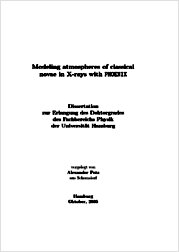| dc.contributor.author | Petz, Alexander | |
| dc.date.accessioned | 2010-10-12T18:25:39Z | |
| dc.date.available | 2010-10-12T18:25:39Z | |
| dc.date.issued | 2005 | |
| dc.identifier.uri | http://hdl.handle.net/11858/00-1735-0000-0001-310D-4 | |
| dc.description.abstract | PHOENIX has been used to calculate model atmospheres of classical novae in the X-ray spectral range. The models account for an expanding, one-dimensional spherically symmetric medium in full non-local thermodynamic equilibrium. Nova atmospheres have been modeled with PHOENIX since the early 90's to fit the early nova spectra in the ultraviolet and infrared spectral ranges. In this work the PHOENIX-code has been enhanced to also model X-ray spectra. This was accomplished by accounting for atomic data and physical processes. The synthetic spectra were compared to observations from the LETGS onboard the CHANDRA X-ray satellite. The template is the observation of nova V4743 Sagittarii in March 2003. The spectrum is very spectacular because of the nova brightness and CHANDRA's spectral resolution. Further observations from July2003, September 2003, and February 2004 were taken. Models with solar and non-solar abundances have been calculated and the synthetic spectra have been fitted to the four observations. The fits were used to discuss discrepancies between models and observations. The effective temperature of the atmosphere, the hydrogen column density, and the abundances ofhelium, carbon, nitrogen, oxygen, and iron in the shell were determined by the fits. It was examined how the parameters evolve with time. With the models the atmosphere structure and NLTE effects were determined. The models were compared to the previous nova model atmospheres from PHOENIX ... | |
| dc.format.extent | 196 S. | |
| dc.format.mimetype | application/pdf | |
| dc.language.iso | eng | |
| dc.publisher | Univ. Hamburg | |
| dc.rights.uri | http://e-docs.geo-leo.de/rights | |
| dc.subject.ddc | 523 | |
| dc.subject.gok | THU 155 | |
| dc.subject.gok | THN 400 | |
| dc.title | Modeling atmospheres of classical novae in X-rays with PHOENIX | |
| dc.type | monograph | |
| dc.subject.gokverbal | Eruptionsveränderliche {Astronomie: Sterne} | |
| dc.subject.gokverbal | Sternatmosphären {Astronomie} | |
| dc.identifier.doi | 10.23689/fidgeo-133 | |
| dc.identifier.ppn | 508428866 | |
| dc.identifier.urn | urn:nbn:de:gbv:18-27427 | |
| dc.type.version | publishedVersion | |
| dc.relation.collection | Astronomie, Astrophysik, Weltraumforschung | |
| dc.description.type | thesis | |


